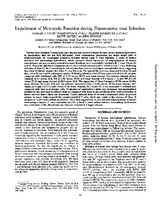Mostrar el registro sencillo del ítem
Impairment of monocytic function during Trypanosoma cruzi infection
| dc.contributor.author | Louie, Michael J | |
| dc.contributor.author | Cuna, Washington R | |
| dc.contributor.author | Rodríguez de Cuna, Celeste | |
| dc.contributor.author | Mayer, Lloyd | |
| dc.contributor.author | Sperber, Kirk | |
| dc.date.accessioned | 2017-12-15T13:58:55Z | |
| dc.date.available | 2017-12-15T13:58:55Z | |
| dc.date.issued | 1994-11 | |
| dc.identifier.uri | http://repositorio.umsa.bo/xmlui/handle/123456789/14236 | |
| dc.description.abstract | During acute infection, Trypanosoma cruzi, the etiologic agent of Chagas' disease, causes immunosuppression by mechanisms that are not fully delineated. Since mononuclear phagocytes are major target cells in trypanosomiasis, we investigated monocytic function during acute T. cruzi infection. A series of human monocyte and macrophage hybridomas, which represent clonal expansions of subpopulations of human macrophages and possess many normal monocytic functions, were successfully infected with T. cruzi. Clones 63 and 53, chosen for stability in long-term culture, were studied extensively after infection with T. cruzi. Following infection of clone 63, the trypomastigote did not transform into the amastigote multiplicative form, suggesting that clone 63 did not support the entire T. cruzi life cycle. The typical life cycle was completed in clone 53, and thus, clone 53 was used in subsequent studies. Following infection, clone 53 lost expression of class II antigens compared with uninfected cells (DR of 2.2% versus 29.3% and mean channel fluorescence intensity [mean channel] of 4.1 versus 30.5, DQ of 2.3% versus 15.6% and mean channel of 5.4 versus 11.4, and DP of 6.3% versus 27.2% and mean channel of 10.3 versus 33.4). The expression of Class I antigens (87.9% versus 82.8%; mean channel, 20 versus 120) and the adhesion molecules LFA-1 (72.9% versus 28.7%; mean channel, 50.7 versus 23.7) and LFA-3 (10.8% versus 0.7%; mean channel, 20.7 versus 15.1) was increased in infected cells compared with that in uninfected cells. Production of interleukin-1 alpha was decreased and interleukin-6 production was increased in infected clone 53 compared with those in the uninfected cells, while production of tumor necrosis factor alpha was increased. Finally, infected clone 53 showed a decreased ability to present antigen to major histocompatibility complex-matched T cells, which may relate to the absence of Class II antigens or to aberrant cytokine production. These data suggest that (i) only selected subpopulations of human macrophages support T. cruzi replication and (ii) at least in some subpopulations, macrophage dysfunction may contribute to the altered immune function observed in Chagas' disease. | es_ES |
| dc.language.iso | en | es_ES |
| dc.publisher | Clinical and Diagnostic Laboratory Immunology | es_ES |
| dc.subject | DETERIORO DE LA MONOCYTICA | es_ES |
| dc.subject | TRYPANOSOMA CRUZI | es_ES |
| dc.subject | ENFERMEDAD DE CHAGAS | es_ES |
| dc.title | Impairment of monocytic function during Trypanosoma cruzi infection | es_ES |
| dc.type | Article | es_ES |

